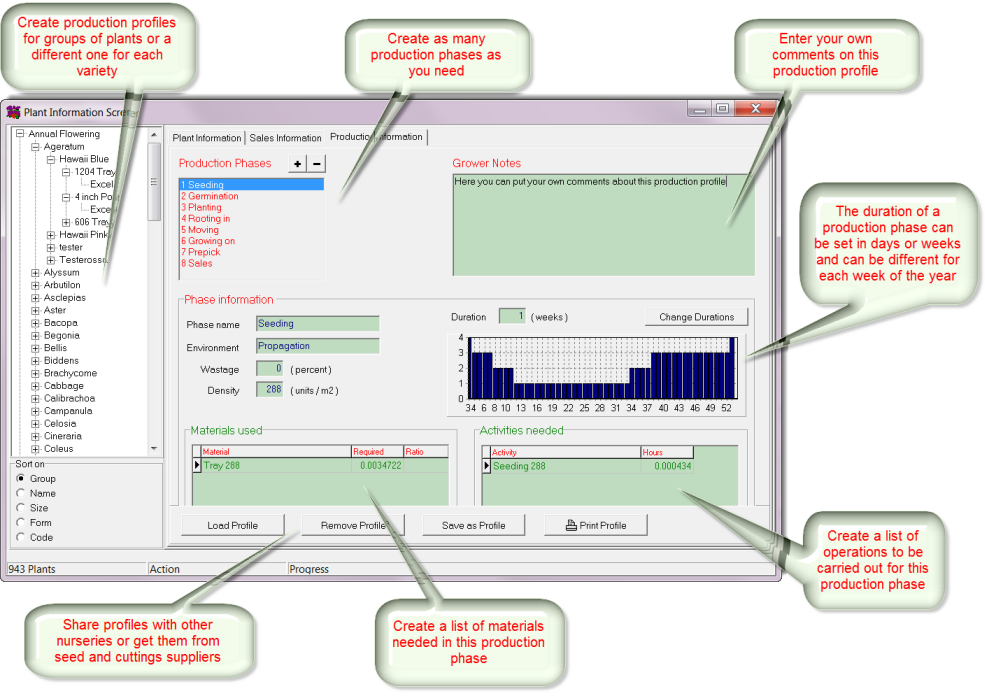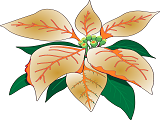A complete definition for the production of a plant
A HortiBench Plant Production Profile defines the production or growing cycle of a specific plant. It includes the lead time of every phase of the production process measured in days or weeks. For each production phase it includes the growing environment the plant requires, the materials used to produce the plant and the specific treatments and operations on the plant. In short, it is a complete recipe for the production of the plant.
As many production phases as you want
The total production cycle can be split up in one or more production phases which can be freely chosen to reflect your nursery operations. Production phases are usually chosen to reflect specific growing conditions. These conditions can be either a physical plant stage, a certain growing environment or just a series of operations. One production profile is used for the entire production cycle. You can use different production profiles per plant group, one for each species you grow, or a production profile for all plants with a certain pot or tray size.Grow to Sell or grow to Harvest
Production Profiles can be made for plants that you grow to sell like pot plants, but also for crops that you grow to harvest, like cut flowers or vegetable plants. A special Harvest Phase is introduced in this production profile which, linked with a choice of yield model, lets you sell harvested products at several times during the production cycle of the plant.Multiple production methods
One production profile can be used to grow a certain species from seed directly in the final container while another version is used to grow the same species via transplanting or from bought-in plugs or young plants. The system is totally flexible and can be as simple or complex as your nursery requires.
Growers' Knowledge
A Plant Production Profile can be used by you, the grower to define and record your growing knowledge and experience about certain plant varieties. By defining these Plant Production Profiles for the range of plants you grow, you will have a record of all the growing knowledge of the nursery which can be accessed by other members of staff whenever the grower is not available.
Not dependent on key staff who know it all
What happens on your nursery when the main grower is off sick for a day ... or a week? What happens when he leaves altogether for another job? Do not find yourself in a situation where you have to scramble to get all the important growing knowledge about your plants on paper. Start now! The devil is in the detail, and questions like: why we do this, or how much do we use of that product, or can we put those together etc. they always come up at the wrong time.From simple to detailed over the years
HortiBench production profiles can simply consist of 2 phases - growing and sales - or they can be complex affairs with 6, 8 or many more phases. Normally you would start off simple and over the years get more and more detail in them. Not only increasing the number of phases but for instance adding materials and operations ... or making the phase durations variable during the year. HortiBench has all these possibilities in there ... you just take your own pace to build and refine them. You can start by having one production profile for each plant group, then the year after tweak it for each species within that group. Finally you might end up with different profiles for varieties that need special attention. Alternatively you might start off with a production profile for each pot or tray size you grow. Then the year after you differentiate the profiles for each species within that pot size etc.Actual Data Registration with the Track & Trace Module
All production planning and control within the HortiBench software is based around the Plant Production Profiles and you can therefore easily copy them from one plant variety to another. You can also allocate a single Production Profile for a whole group of plants. Production Profiles can be tweaked to exactly reflect the measures and timings used on your nursery. After a production plan has been made and put in place, you can save the actual information and use it to tweak the original Plant Production Profile. This will result in better and more accurate planning for the next batch of plants or for the next growing season.
Profile Exchange
Plant Production Profiles can also be exchanged between nurseries to exchange growing information. For example: a nurseryman who talks with another grower who faces some challenges growing a specific species can simply give him his Production Profile on a USB stick or send it to him by email. The grower can view the Plant Production Profile with HortiBench and see all the detailed growing information. He can then also link it into his HortiBench schedule and base his production, staff and space planning for that variety on it.
The HortiBench Data Repository
Suppliers of seeds, plugs, starter plants, fertiliser and many other products can supply their customers with Plant Production Profiles to give them guidance on the use of their product. For example: a seed supplier with a new variety can promote its adaptation by growers by supplying them with a Plant Production Profile which tells them in detail how to grow the new variety, from germination rates to phase timings and temperature settings. A fertiliser manufacturer can supply Plant Production Profiles to his customers for the species and pot/tray sizes they grow which has exact measures of fertiliser to use and at which stage. If these customers then record their actual growing information in the Plant Production Profile, this can be used as feedback to the supplier for evaluation purposes. Production Profiles can be uploaded and downloaded from the web site which has a repository for them. We can imagine that growers, suppliers and grower organisations will add to the catalogue and build and tweak Production Profiles for different climatic regions. Since the information in a Production Profile can be highly sensitive to the grower we have developed an encryption and password protection facility. If needed, Plant Production Profiles can be protected, and read only by the people who have the password.
